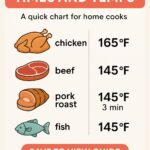
Nonstick pans are weeknight heroes. Eggs slide, fish releases, pancakes flip, and cleanup takes about thirty seconds. The catch is that nonstick surfaces are more fragile than stainless or cast iron. A few rough habits chip away at glide fast, while a handful of smart ones can add years. Think moderate heat, gentle tools, simple soap and water, and no aerosol sprays. This checklist keeps it practical. You will see how to preheat without scorching, which oils behave best, how to clear sticky film without scratching, and the storage tricks that stop mystery scuffs. Follow these small moves and breakfast will keep slipping instead of sticking.
What ruins nonstick fast
- High heat on an empty pan for more than a minute
- Aerosol cooking sprays that bake into sticky film
- Metal tools that nick the coating, even once
- Abrasive pads or powders that scratch while “deep cleaning”
- Dishwasher cycles that dull the surface and loosen rivets over time
- Thermal shock from cold water on a hot pan
- Stacking bare-on-bare under heavy pots
Daily cooking checklist
Before heat
- Pick the right burner size for the pan base.
- Dry the pan completely. Trapped droplets leave speckles.
Preheat
- Warm on low to medium for 1 to 2 minutes. Nonstick works best below searing temps.
- Add a few drops of regular oil or butter if you want extra slip. Avoid aerosols.
While cooking
- Use silicone, wood, or nylon tools.
- Keep heat at medium or below. If oil smokes, it is too hot for nonstick.
- Avoid broilers and ovens above the brand’s limit. Many pans top out near 400 to 450°F.
After cooking
- Let the pan cool a few minutes. Then wash by hand with warm water, mild dish soap, and a soft sponge.
- Wipe the rim and rivets. Residue there becomes sticky rings later.
Cleaning that keeps glide
- Everyday: Warm water, drop of soap, soft side of a sponge. Rinse well.
- For light film: Make a quick baking soda paste (1 tsp soda + a little water). Rub gently with a soft sponge, rinse, and dry.
- For stubborn spray buildup: Simmer a thin slurry of water and baking soda 2 to 3 minutes, cool, then wipe.
- Skip: Steel wool, scouring powders, oven cleaner, and magic erasers on dark coatings. They can microscratch and dull release.
Dry completely. Water spots bake on the next time you heat up.
Storage that prevents scratches
- Nest with pan protectors, paper towels, or a clean cloth between pans.
- Do not store heavy cast iron on top of nonstick.
- If space allows, hang by the handle or slide into a rack vertically.
Oil and spray rules
- No aerosol sprays. The propellants and emulsifiers create a varnish that defeats nonstick.
- Yes to regular oils. Canola, avocado, peanut, or refined olive oil are fine at medium heat.
- Butter or ghee for flavor is fine. Add once the pan is warm so milk solids do not scorch.
Heat boundaries that extend life
- Keep it low to medium for eggs, pancakes, fish, and sautéing. Use stainless or cast iron for high heat searing.
- Never heat bone dry for long. If you need a quick warmup, one minute is enough.
- Avoid sudden chills. Let the pan cool before rinsing.
Ceramic vs PFAS nonstick care notes
- Ceramic nonstick likes even gentler heat. It benefits from a light oil wipe before the first use and occasionally after deep cleaning.
- PFAS nonstick (classic PTFE) does not need seasoning, but a thin oil film after washing can help resist water spots and keep glide silky.
- Both types hate aerosol sprays, harsh scrubs, and knife-edge tools.
Quick revive steps when food starts to stick
- Wash with warm soapy water.
- Use the baking soda simmer for film. Rinse and dry.
- Wipe a drop of oil over the cool surface with a paper towel. Buff off excess.
- Test at low heat with an egg. If sticking remains or you see deep scratches or peeling, it is time to replace.
When to replace a nonstick pan
- Coating is chipped, flaking, or deeply scratched
- Surface looks blistered or rainbowed from repeated overheating
- Pan is warped and will not sit flat
- You have to crank heat just to release an egg
Nonstick is a wear item. With good habits many owners get 2 to 5 years of easy use per pan, depending on thickness, coating type, and how often it cooks.
One-page checklist to print
- Cook on low to medium
- No aerosol spray ever
- Silicone or wood tools only
- Hand wash with soft sponge
- Baking soda paste for film
- Cool before rinsing
- Separate layers when stacking
- Replace if chipped, peeling, or warped
Final Thoughts
Nonstick pans are amazing for eggs, fish, pancakes, and busy weeknights, but they need gentle treatment. Keep heat moderate, skip aerosol sprays, clean softly, and store with a buffer. Those small habits keep glide smooth and breakfast stress free far longer than a warranty ever will.
See Also
If you are choosing a new pan or comparing coatings, start with Best Nonstick Frying Pans: PFAS vs Ceramic. It explains coating differences, heat limits, and which surface fits your style. If you lean toward ceramic sets with a cleaner look, our Caraway Nonstick Ceramic Cookware Set Review covers real kitchen quirks, and Our Place Cookware Review breaks down how multiuse pieces perform with lower heat.
For tasks that do not belong on nonstick, borrow gear built for abuse. Searing and stock prefer metal workhorses, so compare All-Clad D5 Brushed Stainless Steel Cookware Set Review for everyday browning and All-Clad 8-Quart Stainless Steel Stockpot Review for soups and big pastas. If you want an affordable enameled oven that handles oven finishes without babying, Best Le Creuset Dutch Oven Dupe shows solid alternatives that hold heat and clean up easily.
FAQs
Do I need oil or butter in a nonstick pan
Usually a few drops help with flavor and even browning. Skip aerosol sprays. Their propellants bake into a gummy film that defeats nonstick.
What heat level should I use
Stay at low to medium for the majority of cooking. If oil smokes, it is too hot for nonstick. Use stainless or cast iron for high-heat searing.
Can nonstick go in the oven
Check your brand’s limit. Many pans are safe up to 400–450°F. Lids and handles may be rated lower. Never use under a broiler.
Is the dishwasher OK
Hand washing is best. Dishwashers dull coatings and can loosen rivets over time. Warm water, mild soap, soft sponge.
How do I remove sticky buildup without scratching
Try a baking soda paste or a brief simmer with water plus baking soda, then wipe with the soft side of a sponge. Rinse and dry fully.
Which utensils are safe
Silicone, wood, and nylon. Skip metal spatulas and knives. One nick can become a peel later.
Why is food sticking even at low heat
You may have film from sprays or residue at the rivets and rim. Do the baking soda clean, dry well, and wipe a dot of regular oil across the cool surface before the next use.
Is ceramic nonstick cared for differently than classic PFAS nonstick
Both dislike high heat, sprays, harsh scrubs, and metal tools. Ceramic benefits from slightly gentler heat and an occasional light oil wipe after deep cleaning.
Can I preheat an empty nonstick pan
Briefly, for a minute at most on low to medium. Long, dry preheats overheat the coating and shorten its life.
Why avoid cold water on a hot pan
Thermal shock can warp the base and stress the coating. Let the pan cool a few minutes before rinsing.
How should I store nonstick
Do not stack bare-on-bare. Use pan protectors, paper towels, or a cloth between pans. Keep heavy pots off the stack.
When should I replace a pan
If the surface is chipped, flaking, blistered, deeply scratched, or you need high heat just to release an egg, retire it.
Affiliate Disclosure
If you purchase through links on our site, we may earn a small commission at no extra cost to you.




